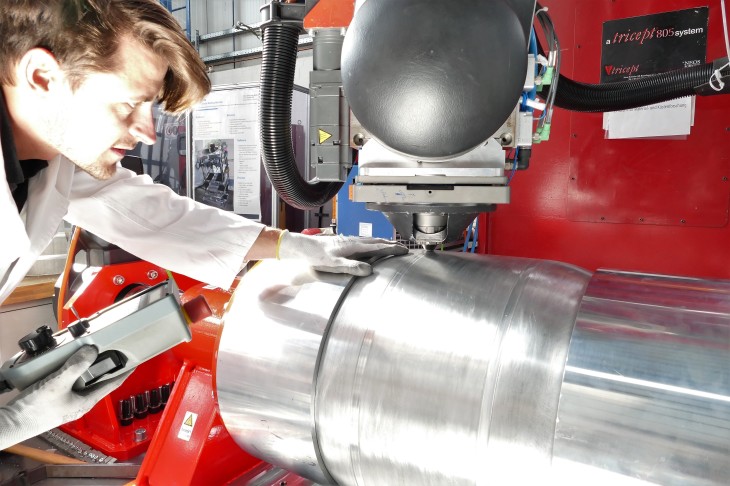Reduce Space Junk
Aluminium propellant tanks will hopefully accompany European satellites into space in the future. Helmholtz-Zentrum Geesthacht is researching one aspect of the complex manufacturing process of these tanks. In the long term, the new tank concept aims to reduce further space debris. The European Space Agency (ESA) is a partner on this project.
![PhD student Jannik Entringer holds one of the tank's prototypes in his hands. This tank weighs seven kilos unfilled and holds around 100 liters of fuel. [Photo: HZG/Heidrun Hillen] Jannik Entringer mit dem Tank](/imperia/md/images/hzg/presse/pressemitteilungen/2019/fittosize__730_0_818d22d649db30ecef408f98d37bf239_jannik_2.jpg)
PhD student Jannik Entringer holds one of the tank's prototypes in his hands. This tank weighs seven kilos unfilled and holds around 100 liters of fuel. [Photo: HZG/Heidrun Hillen]
Satellites orbit Earth– these days, accompanied by plenty of junk. Approximately 20,000 sizeable objects and up to 900,000 centimetre-sized parts are racing through space at about 30,000 kilometres per hour. The small parts are posing a growing danger for satellites and space stations: The energy released upon impact is comparable to that of a car driving into a concrete wall.
Waste incineration in space
Further space debris must be avoided. That is why the European Space Agency (ESA) has a policy stating that every new satellite must leave space after a maximum of 25 years, and satellites that are no longer operational must be disposed of. One way of doing this is a controlled crash. This involves manoeuvring the satellite back into Earth’s atmosphere, where it burns up upon entry. The problem: some of the satellite’s components, such as the tanks, are made of the light alloy titanium. Titanium doesn’t burn up completely when re-entering the atmosphere, meaning that large parts crash into the earth. It thereby represents a danger to people and infrastructures.
Materials with a lower melting point, for example aluminium, would be more suitable as a structural material for the tanks, as they would definitely burn up when re-entering the atmosphere. However, manufacturing such tanks comes with challenges: In conventionally welded aluminium tanks, the high process temperatures cause critical changes in the material. The tremendous forces during a rocket launch could lead to catastrophic defects in the weld seam of the satellite tank.
Special welding procedure for satellite tanks

Space junk in orbit. Photo: NASA/728145
Scientists at Helmholtz-Zentrum Geesthacht (HZG) are currently researching special welding procedures, such as friction stir welding, which could present a solution. “With our procedures, we combine a wide range of materials entirely without melting, sparks, or vapours. The components are firmly joined through friction. This process takes place at a temperature below the melting point of aluminium. Friction stir welding substantially reduces problematic stress states in the material,” says Jannik Entringer, PhD student at the HZG Institute of Materials Research. This means that the friction stir-welded tank will master take-off but burn up when it returns.
These oval tanks are currently undergoing tests in Geesthacht, and the ESA is eagerly awaiting the results. The satellite tank can hold nearly 100 litres of propellant, weighs about seven kilogrammes, and consists of a high-strength aluminium-lithium alloy. As part of his dissertation, PhD student Entringer has carried out comprehensive, knowledge-based process optimisations with the goal of determining the perfect combination of process parameters to achieve the necessary microstructure and connection properties for this application. He is using the bobbin tool process variant to achieve this, a two-shoulder tool that joins the components at the weld from above and below.
“The components of the bobbin tool are under a very high mechanical strain. The forces and temperatures should therefore be set as precisely as possible during the welding process. I continually adjusted the feed, pressure, or rotation and examined the effects on the nano level up to the macro level,” says Entringer. Over the course of his PhD research, he worked out the connection between process-related microstructure changes and stress crack corrosion for the first time using different characterisation methods.
Prototype development at HZG

Jannik Entringer is testing the weld. Photo: HZG/Heidrun Hillen
Aside from developing the welding process, PhD student Jannik Entringer was also in charge of the clamping device and reshaping the tank components. Due to the high forces in play during the welding process, he had to construct a system that applies torque of up to 2,000 Newton metres.
Entringer: “I am quite proud that our procedure is working. In addition to the high torque, we also had to take the round shape into account. Dimensional accuracy turned out to be a particularly critical factor. I hope that my research will contribute to cleaner Earth’s orbits one day.” For the time being, the tank prototypes that he welded are being sent back to the ESA, where they will be exhibited and examined.
HZG Department "Solid State Joining Processes"
Contact for the media:
Helmholtz-Zentrum Geesthacht
